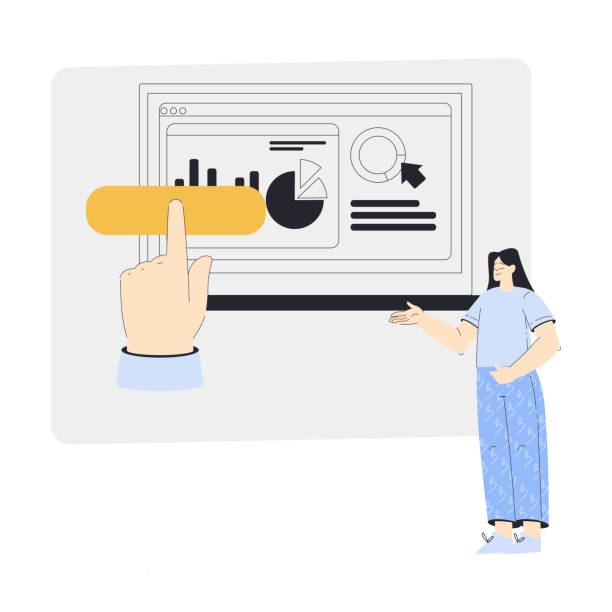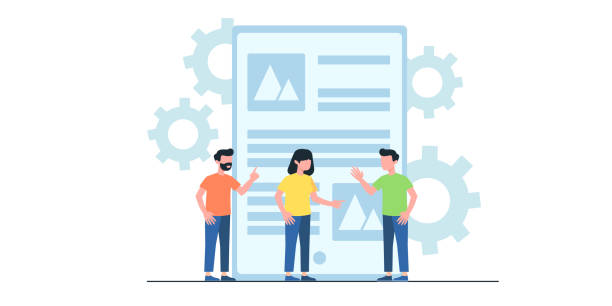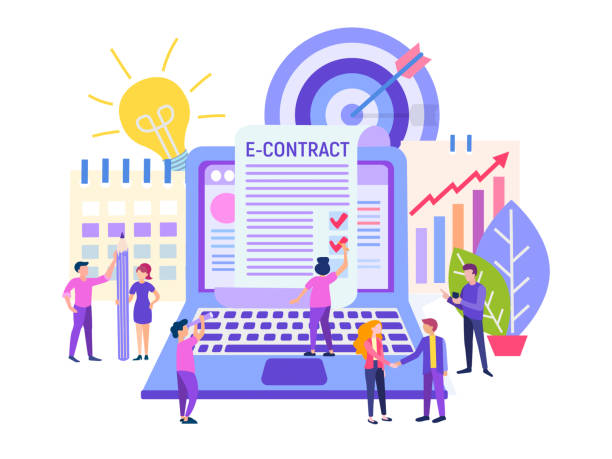Introduction to Modern UI Website Design

In today’s digital world, where competition for user attention intensifies by the moment, modern UI website design is no longer a luxury choice, but an undeniable necessity.
This approach goes beyond mere aesthetics, focusing on creating a seamless, enjoyable, and efficient experience for users.
#Modern_UI encompasses a set of principles and techniques aimed at building websites that not only look appealing but are also easy to use and address users’ actual needs.
This new paradigm in web design is built upon a deep understanding of user behavior, cognitive psychology, and technological advancements.
This explanatory and educational section will help you become familiar with the fundamental concepts of modern website design.
From the importance of a user’s first interaction with a website to how to retain them for longer periods, everything ties back to a powerful modern UI website design.
A website that can convey its message at a glance and guide the user towards the desired action will undoubtedly achieve greater success.
This means optimizing the user’s path and providing relevant content at the right time.
Are you dissatisfied with the low conversion rate of visitors to customers on your e-commerce site?
With professional e-commerce website design by Rasaweb, solve this problem forever!
✅ Increase visitor-to-customer conversion rate
✅ Create an excellent user experience and gain customer trust
⚡ Get free consultation
The Importance of User Experience (UX) in Modern Design

User Experience (UX) forms the core of any modern UI website design.
In fact, no matter how beautiful a user interface is, if it provides a poor user experience, it is doomed to fail.
UX deals with the user’s feelings, attitudes, and perceptions before, during, and after interacting with a product or website.
This includes aspects such as usability, accessibility, value, desirability, and efficiency.
Analytical research shows that websites with strong UX have higher conversion rates and users spend more time on them.
UX designers strive to provide an intuitive and friction-free path for users to achieve their goals by understanding user needs and behaviors.
This process often involves user research, persona creation, user journey mapping, and iterative testing.
From an explanatory perspective, UX can be said to be a bridge between the business and the end-user, ensuring that the product not only meets business requirements but is also valuable and enjoyable for users.
Investing in user experience means investing in the long-term success of a digital project.
This analytical perspective shows us how an efficient and user-friendly design can make a significant difference in a website’s performance and differentiate it from its competitors.
Principles of Attractive and User-Friendly User Interface (UI) Design

User Interface (UI) design is the visual and interactive part of modern UI website design that users directly interact with.
This section includes the selection of colors, fonts, element layout, buttons, icons, and all visual aspects that make the website attractive and understandable.
Fundamental principles in designing an attractive and user-friendly UI include: simplicity, consistency, feedback, accessibility, and visual hierarchy.
Simplicity means removing unnecessary elements and focusing on the main content to prevent user confusion.
Consistency refers to maintaining uniformity in design and layout across all website pages, which creates a sense of familiarity and trust in the user.
Feedback means providing an appropriate response to user actions (e.g., changing button color after clicking).
Accessibility ensures that the website is usable by all users, including those with disabilities.
Visual hierarchy helps guide the user’s eye to the most important elements on the page.
This specialized and educational section highlights the importance of these principles in creating an efficient and innovative user interface.
Correct application of these principles ensures that your website not only looks beautiful but also performs highly.
Below is a table comparing good and bad UI design principles, which can help in better understanding these concepts.
| Design Principle | Good Design (Example) | Bad Design (Example) |
|---|---|---|
| Simplicity and Clarity | Clear navigation menu with minimal options | Cluttered menu with too many nested items |
| Visual Consistency | Using a consistent color palette and font throughout the site | Sudden changes in font and color on different pages |
| Immediate Feedback | A button that changes color or shows a confirmation message after clicking | A button that shows no reaction after clicking |
| Accessibility | Alt tags for images and appropriate color contrast | Small text with poor contrast, no Alt tags |
The Role of Color and Font Psychology in Modern Design

Color and font psychology are two powerful, hidden elements in modern UI website design that can subconsciously influence users’ emotions and behavior.
Each color has specific meanings and associations.
For example, blue typically evokes a sense of trust and calmness, while red can signify passion, excitement, or danger.
Green is associated with nature and growth, and yellow brings a feeling of happiness and optimism.
Designers specializing in this field, with a deep understanding of color psychology, choose color palettes that align with the website’s message and goal, helping to strengthen the brand.
Fonts play an equally vital role.
Serif fonts usually convey a sense of tradition, formality, and authority, while Sans-serif fonts are more modern, cleaner, and better suited for readability on digital screens.
Font size, weight, and spacing between letters and lines (leading and kerning) all impact readability and visual experience.
This specialized and explanatory section addresses the importance of carefully selecting these elements in creating an advanced user interface that can convey hidden messages to the user and provide a pleasant visual experience.
Color psychology and font are not limited to aesthetics; they are powerful tools for non-verbal communication with the user.
Are you dissatisfied with the low sales of your e-commerce site?
Rasaweb is your solution for having a professional and high-selling e-commerce site.
✅ Significant increase in sales and revenue
✅ Easy and enjoyable shopping experience for customers
⚡ Get a free consultation from Rasaweb now!
Responsive Design: A Prerequisite for Modern Web

In the current era, where users access the internet from a wide range of devices including smartphones, tablets, laptops, and even smart TVs, Responsive Design has become a vital element in modern UI website design.
Responsive design means that your website can automatically adapt its layout and elements to the screen size and device of the user.
This ensures that the user experience remains seamless, efficient, and visual, regardless of the device size.
In other words, there is no longer a need to design separate versions for mobile and desktop; instead, one website intelligently adapts itself to the display environment.
This educational and guiding approach also highlights the importance of Mobile-First design; meaning we design for the smallest screens first and then progressively enhance it for larger devices.
This ensures that the core user experience is optimized from the outset, guaranteeing website performance on mobile devices, which constitute the majority of internet traffic.
Without responsive design, your website may perform poorly on various devices, leading to user dissatisfaction, reduced engagement, and ultimately, a drop in search engine rankings.
New Tools and Techniques in Website Design

The industry of modern UI website design is rapidly evolving, with new tools and techniques constantly being introduced that make the design process more efficient and creative.
In this news and specialized section, we will explore some of these innovative tools and techniques.
Tools like Figma, Adobe XD, and Sketch allow designers to quickly create interactive prototypes and complex wireframes, and view changes in real-time.
These tools also facilitate team collaboration, enabling multiple designers to work on a single project simultaneously.
In terms of techniques, the concept of “Design Systems” has become very prominent.
A design system is a collection of reusable principles, components, and patterns that maintain visual and functional consistency across large projects and significantly accelerate development speed.
Furthermore, the use of UI frameworks such as React, Vue.js, and Angular has become very common in modern website development.
These frameworks, by providing ready-made components and a modular programming structure, speed up the implementation of complex designs and help developers build high-performance and scalable websites.
In addition, Content Management Systems (CMS) like WordPress and Webflow also offer powerful visual capabilities, making contemporary UI website design accessible even to non-programmers.
Challenges and Solutions in UI Design in 2024

With rapid technological advancements, modern UI website design faces new challenges in 2024 that require innovative solutions.
One of the biggest challenges is managing complexity and ever-increasing user expectations.
Today’s users expect websites to be not only beautiful and user-friendly, but also personalized, very fast, and accessible on any device.
This thought-provoking and analytical section examines these challenges and offers solutions.
Another challenge is the integration of Artificial Intelligence (AI) and Augmented Reality (AR) into UI design.
How can these technologies be integrated in a way that enriches the user experience rather than making it more complex? Solutions include using AI for content and experience personalization, improving search processes and product recommendations, and providing intelligent chatbots for user support.
Additionally, ensuring accessibility for all users, regardless of their abilities, remains a significant challenge and requires continuous attention.
Suggested solutions include continuous training for designers, using automated and human accessibility testing tools, and adhering to WCAG standards.
The table below shows some key challenges and related solutions for modern website design this year.
| Challenge | Proposed Solution |
|---|---|
| High user expectations (speed, personalization) | Performance optimization, using AI for content personalization |
| Integration of new technologies (AI, AR) | Scenario-based design, extensive usability testing |
| Accessibility for all | Adherence to WCAG standards, use of accessibility testing tools |
| Data security and privacy | Transparency in data collection, implementation of strong security protocols |
The Future of Modern UI Website Design

The future of modern UI website design is moving towards blurring the lines between reality and digital space.
This analytical and entertaining section delves into exciting predictions in this field.
We expect to see an increased use of Voice User Interfaces (VUIs), which allow interaction with websites through voice commands, making the user experience more natural and hands-free.
Furthermore, with advancements in Virtual Reality (VR) and Augmented Reality (AR), websites might transform into 3D spaces and immersive experiences where users can navigate and interact with content in entirely new ways.
This could revolutionize the world of marketing and e-commerce.
More advanced personalization is another future trend.
With the help of Artificial Intelligence, websites will be able to dynamically personalize the experience based on user needs, interests, and even momentary emotional states.
This means more targeted content, more precise recommendations, and optimized navigation for each individual.
Intelligent and adaptive UI design, where the user interface changes based on user behaviors and preferences, is also a promising area.
The future of user interface will be less confined to screens and will expand more into multimodal and natural interactions with the digital space.
Did you know that poor online store design can drive away up to 70% of your potential customers? Rasaweb transforms your sales with professional and user-friendly e-commerce website designs.
✅ Significant increase in sales and revenue
✅ Full optimization for search engines and mobile
⚡ [Get Free Consultation from Rasaweb]
Successful Case Studies in Modern Website Design

To better understand the concept of modern UI website design, nothing is better than examining successful real-world examples.
This educational and news section analyzes several case studies of websites that have succeeded in providing an outstanding digital experience through creative and user-centric design.
For example, Airbnb’s website, with its clean visual design, intuitive navigation, and high-quality images, is an excellent example of a user-friendly interface that has transformed the accommodation booking process into an enjoyable experience for users.
Or the Dropbox website, which has attracted millions of users with its simplicity and efficiency in providing cloud storage services.
Their design focuses on eliminating unnecessary complexities and concentrating on core functionalities.
Stripe, the online payment platform, also exemplifies how to combine aesthetics with functionality in a technical product, with its clean design and very clear and understandable documentation for developers.
From an educational perspective, these examples show that success in modern website design is not limited to visual appeal; rather, it depends on a deep understanding of user needs, simplicity in interaction, and providing real value.
Each of these websites, by focusing on the consistency of user experience across different platforms, has achieved top positions in their respective industries and inspired many designers and developers.
How to Become a Professional Modern UI Designer

Becoming a professional modern user interface designer requires a combination of technical skills, creativity, and a deep understanding of human psychology.
This guiding and educational section outlines a path for those interested in this field.
Firstly, foundational training in UI/UX design principles is essential.
This includes learning concepts such as color theory, typography, layout, visual hierarchy, and user experience principles.
Next, mastering design tools like Figma, Adobe XD, or Sketch is crucial.
These tools will help you transform your ideas into tangible prototypes.
Additionally, a basic understanding of HTML, CSS, and JavaScript can help you collaborate better with developers and expand your design capabilities.
Building a strong and diverse portfolio, including your personal or collaborative projects, is very important for showcasing your skills and design style.
Always try to explain your thought process and design decisions in your portfolio projects.
Participating in workshops, studying specialized articles, following new trends in modern UI website design, and receiving feedback from experts in the field will all contribute to your professional growth.
This path is a continuous journey of learning and improvement, as technologies and user expectations are constantly changing.
Frequently Asked Questions
| Question | Answer |
|---|---|
| What is a modern user interface? | A modern user interface refers to a design that uses new trends, simplicity, excellent user experience, and attractive visual elements. |
| Why is using a modern user interface important in website design? | It helps attract and retain more users, creates a sense of professionalism, improves user experience, and increases conversion rates. |
| What are the main features of a modern user interface? | Simplicity, sufficient use of white space, readable typography, attractive and harmonious colors, subtle animations, and responsive design. |
| How is responsiveness related to modern user interface? | Responsive design is an essential feature in modern user interface that ensures the website displays well on all devices (mobile, tablet, desktop). |
| What is the role of typography in modern user interface design? | Selecting appropriate fonts and using them correctly increases readability and contributes to the website’s beauty and visual identity. |
| What is White Space and why is it important in modern UI? | It is the empty space between different elements on the page that helps improve readability, user focus, and creates a sense of cleanliness and order. |
| What is the benefit of using animations in modern user interface design? | Subtle and purposeful animations can attract user attention, improve interaction, and make information transfer more engaging. |
| How can User Experience (UX) be improved alongside modern user interface? | By understanding user needs, simplifying navigation paths, providing appropriate visual feedback, and easy testability. |
| Does modern user interface always mean using bright colors? | No, a modern user interface can use various color palettes, including dark colors; the important thing is choosing harmonious and brand-appropriate colors. |
| What are the current trends in modern user interface design? | Use of Dark Mode, Neumorphism, Glassmorphism, scroll-based animations, and minimalist design. |
And other services of Rasaweb Advertising Agency in the field of advertising
The role of user experience in the success of online advertising
Advertising on hairdressing educational websites
How to use sponsored ads on social media
Creating charity campaigns for branding hairdressing equipment
The role of color psychology in digital advertising design
And over hundreds of other services in the field of internet advertising, advertising consultation, and organizational solutions
Internet Advertising | Advertising Strategy | Advertorial
🚀 At Rasaweb Afarin Digital Marketing Agency, we help your business shine in today’s competitive world and achieve its goals. From multilingual website design to search engine optimization and social media management, we are with you to ensure a powerful online presence.
📍 Tehran, Mirdamad Street, next to Bank Markazi, Kazerun Jonubi Alley, Ramin Alley, No. 6

